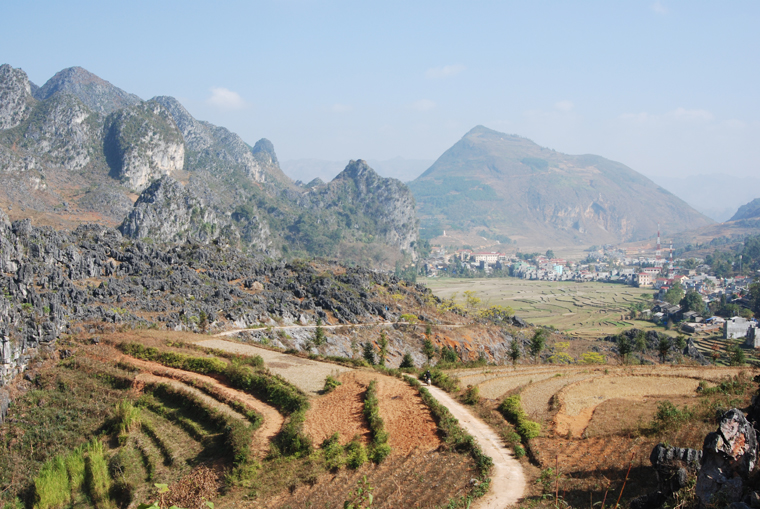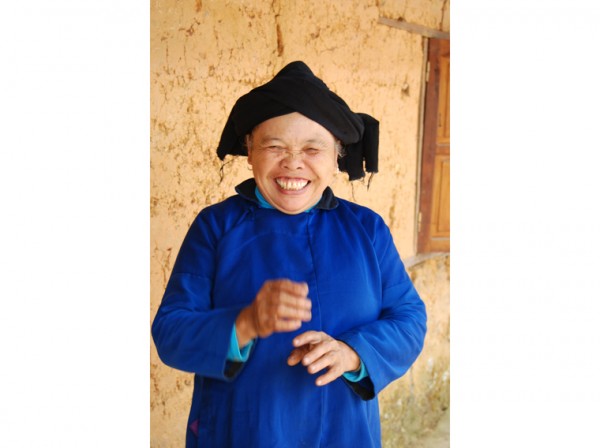Venerable Vietnam
The Toronto Star | Saturday, October 9th, 2010

By Cindy Fan
HA GIANG, VIETNAM—The internal struggle is visible in the old man’s eyes. He can’t hold back any longer.
Curiosity wins over propriety. Grabbing Chris’ arm hair, he gives it a firm tug. Giggles and excited chatter erupt from the crowd.
For the people of remote Ha Giang, this isn’t a typical day at the market.
The province of Ha Giang is 300 kilometres from the capital of Hanoi in Vietnam’s mountainous north, bordering China. It is home to a multitude of hill tribes, dubbed “montagnards” by the French. Heading to this region is something I’ve wanted to do since seeing a photo of a Black Hmong girl, face beaming and dressed in an exuberantly colourful tribal outfit. The photo was a revelation about Vietnam’s astounding diversity, a window into a country with a total of 54 recognized ethnic groups.
The picture that drew me to northern Vietnam has come to life. The Tay, Hmong, Hoa and Dao busily shop, their differences striking, their faces, language and dress unique and distinct.
But right now they are all united in their surprise and delight in having two foreigners crash their market.
The man pinches the meat on Chris’ arm and chuckles.
“What are they saying?” I ask our guide, Long. He asks the crowd in Vietnamese and then smiles at the response.
“They like how Chris is hairy and fat. And you are . . . fat and beautiful.”
I laugh out loud, rejoicing in my stature as a giant — relatively speaking. I can’t help but grin ear to ear as I think of a line from the movie The Devil Wears Prada declaring my size 6 as the new 14.
This is Long’s third year with Ethnic Travel, an operator that specializes in cultural experiences in northern Vietnam. He has a deep fondness for retro British comedies like Fawlty Towers and Blackadder, and regularly trawls Hanoi for bootleg DVDs to add to his collection. We bonded quickly the first night, sharing our favourite Monty Python sketches over a few Saigon beers and snack plates of roasted peanuts.
Guiding this trip for a fat and beautiful woman and her hairy and fat British friend is a treat for Long. Most of his travellers flock to Sa Pa, another mountain town in the northwest accessible by train. Marked as a must-see destination on the Southeast Asia tourist circuit, it both prospers and suffers from its popularity.
In Sa Pa, traditional clothing has become more like a costume. Encounters are paid photo-ops, markets a place to sell tourist trinkets.
In stark contrast, Ha Giang remains isolated from the outside world with little tourist infrastructure and Western comforts. Independent travel to the region is restricted and permits need to be purchased.
It is also a tiring day’s drive here from Hanoi on snaking, precarious roads, but worth it for the region’s rugged beauty: limestone mountains, cultivated terraced hills, towering karst formations that sprout from the earth, and precipitous pause-a-while views.
In this busy outdoor market, which occurs twice a month, I see a tribe of women who wear black jackets and a headdress with exquisite red and blue trim. Their sleeping babies, slung on their backs, sport red caps festooned with fringe and tassels. Another tribe bears striped sleeves and intricately embroidered lapels.
Not everyone is so distracted by our presence — this is a place for business after all. I stand unnoticed beside a crowd of women adorned with wide, flat metal necklaces. They bargain with a seamstress over new outfits (black tunics with blue trim). Behind me, a woman in an impressive green turban puts her purchase, a piglet, in her wicker basket.
As I experience all this, I marvel at the remarkable richness and diversity that survives and thrives in this little pocket of Vietnam and contemplate the boring sameness that has swept the world. Even in the most remote and distant of places, it is rare not to see at least one local wearing a Nike shirt or Man U jersey, one Coca-Cola sign or faded picture of Britney Spears plastered to a wall.
Britney-who? Internet? Forget about it. The farms and villages dotting the lonely hills that we have hiked through are without plumbing or electricity. We encountered some people who do not even speak Vietnamese, only their local tongue. Vietnam has 106 individual living languages — 55 in north Vietnam — and these numbers do not include all the dialects.
We are aliens here, but we are most welcome.
I spy a woman selling sugar cane and motion that I would like some. She smiles and steals shy glances at me as she chops away the sugar cane’s tough exterior with a machete. She hands it to me and refuses to take any money. My efforts to insist are futile.
Chris, whose life’s mission is to try every kind of food, especially if it is on a stick, moseys back to me, his hands full of mystery treats after he encountered the same generosity.
“Someone let me taste honey,” he says. “I can’t figure out what this is but it’s good. I wouldn’t try this, though, if I were you.”
He holds up something that can only be described as a sticky fried ball of dough dotted with red chili. Even Long can’t identify it. I try it anyways.
Long snorts with laughter at my facial expressions.
Where are we? I say to myself.
On a whim we have stopped the car somewhere up in the hills and head toward the only sign of life, a few farmhouses at the end of the path. As we approach, a savage-looking dog barks at us with gusto.
An old woman pops her head out the doorway to investigate the commotion and is surprised she has visitors. Foreigners, too! She is delighted, invites us in and scurries about to make us tea.
The one-room home is simple — dirt floor, a bed in a corner. Dark and smoky, the only light and heat comes from a stove in the centre. The attic is chock-full of dried corn, the main staple in this region that is too cold and dry to grow rice.
Long tells me she is Pu Péo, a group with dwindling numbers. A survey done in 1999 counted 705. More recent numbers estimate only 400.
I am so charmed by this old woman that I ask if I can take her portrait. She is thrilled. Brimming with excitement, she dashes around the house to gather and put her best clothes on, a bright blue jacket and black headwrap.
When she sees herself on my digital camera, her reaction is one of pure and utter joy. She points to her photo and laughs and laughs and laughs. Long promises he will return with a print on his next trip to Ha Giang.
As we make our way to the car I turn to catch a last glimpse of the home before it disappears from view. I gaze at her photo and wonder if her image will fade as her people do, becoming ghosts and a vague memory haunting the hard and ancient mountains that will stand impartial to a big singular world moving in.
Cindy Fan is a freelance writer based in Toronto.
Just the Facts
TIPS: Ethnic Travel is based in Hanoi and offers small group/private north Vietnam trips for a range of interests. Permits are required to travel Ha Giang and sometimes difficult to obtain without using an agency or guide.
View the story on The Toronto Star’s website here.
